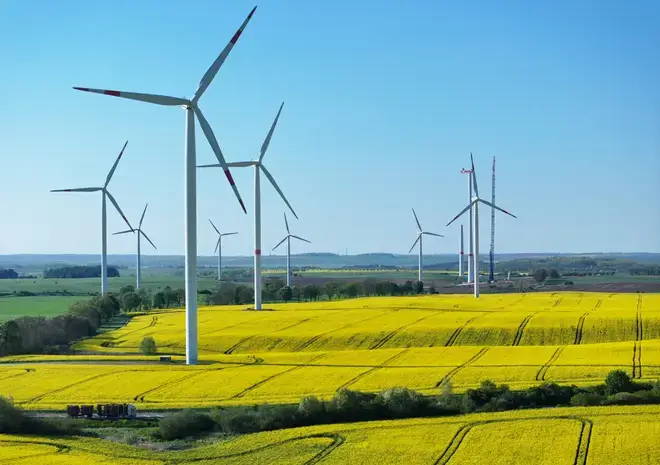The Government has unveiled its plan to almost double onshore wind across England by 2030.
Ministers want to expand the country's onshore wind capacity from 14.8GW to 27-29GW by the end of the decade.
It comes as part of wider Government ambitions to transition towards a clean power system by 2030, with the hope of boosting economic growth, creating jobs, reducing bills, decarbonising the grid and strengthening energy security.
Last year, Labour axed the de facto ban on building onshore wind farms introduced by the Conservatives under David Cameron.
The Government's move put onshore wind on an equal planning footing to offshore wind and nuclear, paving the way for projects to be rolled out faster in the coming years.
In its new strategy, the Government set out 40 actions for ministers and industry to take to hit the 2030 onshore wind ambitions.
These include planning reforms, building supply chains and skilled workforces, resolving issues over how onshore turbines and aerospace infrastructure can co-exist, repowering old turbines, and exploring plans to expand the clean industry bonus for onshore wind.
The Government claims the strategy will support the creation of up to 45,000 skilled jobs by the end of the decade.
In the foreword, Energy Secretary Ed Miliband said: "As one of the cheapest and fastest-to-build sources of power we have, onshore wind will play a critical role in boosting our energy independence with clean power by 2030.
"The reality is that every turbine we build helps protect families, businesses and the public finances from future fossil fuel shocks."
Matthieu Hue, co-chairman of the Onshore Wind Taskforce and chief executive of EDF Power Solutions UK and Ireland, said: "This strategy is focusing on overcoming barriers and challenges we face across the industry in the deployment of onshore wind while capturing the major socio-economic benefits it can bring to the environment and to local economies.
"This is a critical part of making Britain a clean energy superpower and delivering energy security."
The Government said communities that host wind farms will benefit from money for community initiatives, such as new football pitches or libraries, or even bill discount schemes.
A typical 25MW wind farm paying the industry standard of £5,000 per MW of installed capacity per year could deliver £3.75m of funding to be redistributed among the community on local initiatives of their choosing over a 30-year operating life, according to the strategy document.
Elsewhere, the Government recently completed a process to de-risk offshore wind developments, led by the Marine Spatial Prioritisation Programme.
It said this will inform the Crown Estate's marine delivery route map on strategic use of the seabed so that more offshore wind farms can be built in a way that considers all marine sectors, including fisheries, and protects the environment.
'Full swing'
James Robottom, RenewableUK's head of onshore wind delivery, said: "Overturning the unpopular onshore wind ban, which deprived us of one of the quickest and cheapest technologies to build for a decade, was just the start.
"The hard work to make the most of this great opportunity to grow our economy and strengthen the UK's energy security is now in full swing."
Sue Ferns, senior deputy general secretary of trade union Prospect, said: "The lost years resulting from the last government's inexplicable ban have resulted in significant workforce and skills-related challenges that urgently need to be addressed, which hopefully they will be in the forthcoming clean energy workforce plan."

